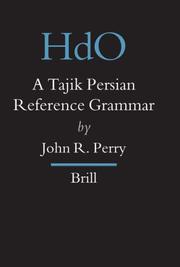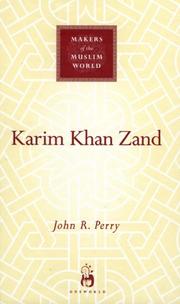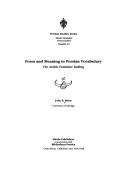| Listing 1 - 10 of 11 | << page >> |
Sort by
|

ISBN: 9004143238 9047414918 Year: 2005 Volume: 11 Publisher: Leiden Boston Brill
Abstract | Keywords | Export | Availability | Bookmark
 Loading...
Loading...Choose an application
- Reference Manager
- EndNote
- RefWorks (Direct export to RefWorks)
Tajik language --- Tadjik (Langue) --- Grammar. --- Grammaire
Book
ISBN: 0226660982 0608094935 1336197110 0226661024 Year: 1979 Publisher: Chicago (Ill.): University of Chicago press
Abstract | Keywords | Export | Availability | Bookmark
 Loading...
Loading...Choose an application
- Reference Manager
- EndNote
- RefWorks (Direct export to RefWorks)
Karīm Khān Zand, --- Zand dynasty. --- Karim Han, --- Vakīl al-Riʻāyā, --- Zand, Karīm Khān, --- كريم خان زند --- Iran --- History

ISBN: 9781851684359 1851684352 Year: 2006 Publisher: Oxford: Oneworld,
Abstract | Keywords | Export | Availability | Bookmark
 Loading...
Loading...Choose an application
- Reference Manager
- EndNote
- RefWorks (Direct export to RefWorks)

ISBN: 0939214679 Year: 1991 Volume: 12 Publisher: Costa Mesa, Calif. : Mazdâ,
Abstract | Keywords | Export | Availability | Bookmark
 Loading...
Loading...Choose an application
- Reference Manager
- EndNote
- RefWorks (Direct export to RefWorks)
Persian language --- Persan (Langue) --- Foreign words and phrases --- Arabic. --- Gender --- Suffixes and prefixes --- Mots et locutions étrangers --- Arabe --- Genre --- Suffixes et préfixes
Book
ISBN: 9789047414919 9789004143234 Year: 2005 Publisher: Leiden;Boston BRILL
Abstract | Keywords | Export | Availability | Bookmark
 Loading...
Loading...Choose an application
- Reference Manager
- EndNote
- RefWorks (Direct export to RefWorks)
This is the first comprehensive reference grammar of Tajik, the Persian of Central Asia, to appear in English. It describes the modern literary language, with examples of colloquial and dialect usage, from the early Soviet period (1920s) up until Tajikistan's independence after 1991. Grammatical examples, taken from a variety of literary sources, are given in both the Cyrillic and Perso-Arabic scripts. Complete verb paradigms, a grammatical index, and parallel word-indexes in both writing systems make it easy to find particular points. Essential for the Iranologist and comparative linguist, for the the student or teacher of Tajik Persian, and a valuable supplement for those who work with Persian of Iran or Afghanistan. With extensive indexes.
Book
Year: 1979 Publisher: Chicago, London University of Chicago Press
Abstract | Keywords | Export | Availability | Bookmark
 Loading...
Loading...Choose an application
- Reference Manager
- EndNote
- RefWorks (Direct export to RefWorks)
Book
ISBN: 9781845119034 9781845118860 1845118863 9781845118877 1845118871 9781845119041 1845119045 1845119053 9781845119058 1845119061 9781845119065 1845119118 9781845119119 1845119185 9781845119188 9781845119102 9781845119126 184511910X 0755610407 0857736531 0857723561 Year: 2013 Publisher: London : Tauris,
Abstract | Keywords | Export | Availability | Bookmark
 Loading...
Loading...Choose an application
- Reference Manager
- EndNote
- RefWorks (Direct export to RefWorks)
After the fall of the Sassanian Empire and with it the gradual decline of Middle Persian as a literary language, New Persian literature emerged in Transoxiana, beyond the frontiers of present-day Iran, and was written and read in India even before it became firmly established in cities such as Isfahan on the Iranian plateau. Over the course of a millennium (ca. 900–1900 CE), Persian established itself as a contact vernacular and an international literary language from Sarajevo to Madras, with Persian poetry serving as a universal cultural cachet for literati both Muslim and non-Muslim. The role of Persian, beyond its early habitat of Iran and other Islamic lands, has long been recognized: European scholars first came to Persian via Turkey and British orientalists via India. Yet the universal popularity of poets such as Sa'di and Hâfez of Shiraz and the ultimate rise of Iran to claim the centre of Persian writing and scholarship led to a relative neglect of the Persianate periphery until recently. This volume contributes to the scholarship of the Persianate fringe with the aid of the abundant material (notably in Tajik, Uzbek and Russian) long neglected by Western scholars and the perspectives of a new generation on this complex and important aspect of Persian literature.
Persian literature --- Persian literature. --- History and criticism. --- Old Persian inscriptions --- Pahlavi literature --- Iranian literature --- Iranian literature. --- Old Persian inscriptions. --- Pahlavi literature. --- Avestisch. --- Altpersisch. --- Mittelpersisch. --- Manichäer. --- Sogdisch. --- Sakisch. --- Folk literature, Persian. --- Iranische Sprachen. --- Mündliche Literatur. --- Oralliteratur --- Persisch. --- Volksliteratur --- Volksliteratur. --- Folk literature. --- Special interest --- Literatur. --- Travel --- Literary criticism --- Literary. --- General. --- Historiography --- Historiography. --- History. --- Iran. --- 1900-1999. --- History --- Littérature iranienne --- Littérature populaire persane --- Histoire et critique --- Littérature iranienne --- Littérature populaire persane
Book
ISBN: 0300220669 9780300220667 0300197993 9780300197990 Year: 2016 Publisher: New Haven Yale University Press
Abstract | Keywords | Export | Availability | Bookmark
 Loading...
Loading...Choose an application
- Reference Manager
- EndNote
- RefWorks (Direct export to RefWorks)
A classic of Modern Persian literature, Charand-o Parand (Stuff and Nonsense) is a work familiar to every literate Iranian. Originally a series of newspaper columns written by scholar and satirist Ali-Akbar Dehkhoda, the pieces poke fun at mullahs, the shah, and the old religious and political order during the Constitutional Revolution in Iran (1906-11). The essays were the Daily Show of their era. The columns were heatedly debated in the Iranian parliament, and the newspaper was shut down on several occasions for its criticism of the religious establishment. Translated by two distinguished scholars of Persian language and history, this volume makes Dehkhoda's entertaining political observations available to English readers for the first time.
Persian wit and humor. --- Political satire, Persian. --- Persian political satire --- Persian wit and humor --- Persian literature --- Iran --- Politics and government. --- Iran--Politics and government.
Book

ISBN: 9781934536568 Year: 2012 Publisher: Philadelphia
Abstract | Keywords | Export | Availability | Bookmark
 Loading...
Loading...Choose an application
- Reference Manager
- EndNote
- RefWorks (Direct export to RefWorks)
Multi

ISBN: 9781934536568 9781934536452 Year: 2012 Publisher: Philadelphia, Pa University of Pennsylvania Press
Abstract | Keywords | Export | Availability | Bookmark
 Loading...
Loading...Choose an application
- Reference Manager
- EndNote
- RefWorks (Direct export to RefWorks)
| Listing 1 - 10 of 11 | << page >> |
Sort by
|

 Search
Search Feedback
Feedback About UniCat
About UniCat  Help
Help News
News